 |
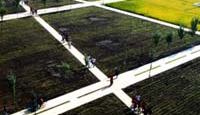
|
 |
 |
The bird's eye view of the productive campus: native crops (rice and buckwheat) are used for the new campus landscape. The paths across the fields are connections between different functional buildings (between student dormitories to classrooms and laboratories) (photo: Kongjian Yu, Chao Yang). |
 |
 |
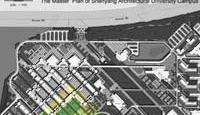 |
 |
 |
Master plan of the campus rice field (photo: Kongjian Yu, Chao Yang). |
 |
 |
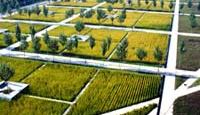 |
 |
 |
Rice paddies distributed in combination with study platform for students for uses away from the classroom. Each platform is covered with a native canopy tree. (photo: Kongjian Yu, Chao Yang). |
 |
 |
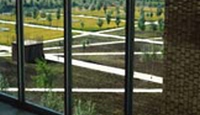 |
 |
 |
Rice fields and buckwheat fields seen from inside the classroom window (photo: Kongjian Yu, Chao Yang). |
 |
 |
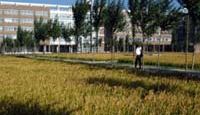 |
 |
 |
The autumn color of rice paddy and the experience of walking through the productive landscape (photo: Kongjian Yu, Chao Yang). |
 |
 |
 |
 |
 |
Details of the rice fields: native popular trees are used for shading, and the path is designed for potential mechanical use as well as for daily pedestrian use with planting band in the center (photo: Kongjian Yu, Chao Yang). |
 |
 |
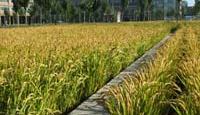 |
 |
 |
Rice fields are made penetrable using concrete narrow paths, that allow students, faculty and staff to touch and feel the rice (photo: Kongjian Yu, Chao Yang). |
 |
 |
 |
 |
 |
 |
 |
 |
 |
 |
|
|
 |
In March of 2002, the Shenyang City in
North China’s
Liaoning Province commissioned the designer to create a new,
80 hectares suburban campus for Shenyang Architectural
University.
Originally located downtown, the university was established
in 1948 and played an important role in educating architects
and civil engineers for the city of Shengyang and for the
country as well. But due to a recent dramatic national
surge
of interest in architecture in China, the enrollment of the
school ballooned, creating congestion and overcrowding
in
its downtown, urban location. After much deliberation, the
school decided the best solution was to move the entire
campus
to the suburbs. This project is one portion of the campus
at the southwest side of the campus, with an area of 3
hectares.
The design had to contend with the following existing site
conditions and budgetary limitations:
- Former agricultural use:
the new site for the proposed campus was originally a
rice field, the
origin of the famous “Northeast Rice,” known
for high quality due to cool climate and its longer growing
season than the those from southern China (one single crop
of rice in this area will last from mid-May until the end
of October, while in southern China it can only last 100
days. This is one reason that rice can be used as a landscaping
material). The soil quality was good and a viable agricultural
irrigation system was still in place.
- Small budget: only about one US dollar
per square meter was allocated for landscaping. Most of
the budget funded the design and construction of 320,000
sq m of new university buildings.
-
Short timeline: the university required
the design to be developed and implemented within one year.
Classes were expected to begin in the fall semester of 2003.
Landscape architects working in China
must address issues of food production and sustainable
land use, two of the biggest
current issues on China’s horizon as the country moves
towards modernization. The overwhelming urbanization process
in China is inevitably encroaching upon a large portion of
China’s arable lands. With a population of 1.3 billion
people, but with only 18% arable land, China is in danger
of using up one of its very valuable and limited resources.
The concept of this design seeks to use rice, native plants
and crops to keep the landscape productive while also fulfilling
its new role as an environment for learning. It is designed
to raise awareness of land and farming amongst college students
who are leaving the land to become city dwellers. In addition,
the designer also seeks to demonstrate how inexpensive and
productive agricultural landscape can become, through careful
design and management, usable space as well.
Major features include:
- The productive campus rice paddy: not only designed to
be a campus with small open platforms, spanning the landscape,
the campus is also a completely functional rice paddy, complete
with its own system of irrigation;
- Other native crops, such as buckwheat grow in rotation across the campus, annually. Native plants line pathways;
- The productive aspect of the landscape draws both students and faculty into the dialogue of sustainable development
and food production. By situating a new architecture school within a functioning rice paddy, the design allows the
process of agriculture to become transparent and accessible to all on campus. Management and student participation
become part of the productive landscape. The farming processes can potentially become a laboratory for students and the
faculty as well.
Golden Rice became an university icon: the rice produced on the campus is harvested
and distributed as “Golden Rice,” serving both as a keepsake for visitors
of the school, and also as a source of identity forthe newly established, suburban campus. But perhaps most importantly
of all, the widespread distribution of “GoldenRice” could raise awareness of new hybrid landscape solutions
that could both continue old, yet crucial uses suchas food production, while supporting new uses, such as the
education of China’s new architects.
|
|
|
|
 |
 |
 |
 |
 |
 |
The Rice Planting Day: the first Saturday after mid May was designated as the Rice planting day for the university. Students and faculty members will celebrate the planting of rice seedlings. It is an unforgettable and unique experience to the students, and is becoming an integral part of the university culture (photo: Kongjian Yu, Chao Yang). |
 |
 |
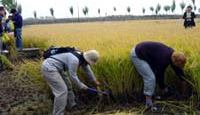 |
 |
 |
The Rice Harvesting Day: The last Saturday of October each year was designated as the Rice Harvesting Day, when all the students and faculty members participate in harvesting the their own rice. This way, the long lost tradition of rice culture in China becomes a campus culture (photo: Kongjian Yu, Chao Yang).
|
 |
 |
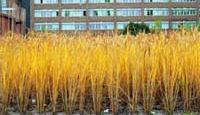 |
 |
 |
Some rice patches were deliberately left on the fields to last until the winter, giving a bright, warm color to the cold atmosphere (photo: Kongjian Yu, Chao Yang).
|
 |
 |
 |
 |
 |
Rice and buckwheat patches left over in the early winter give off a bright, warm color to the cold atmosphere (photo: Kongjian Yu, Chao Yang). |
 |
 |
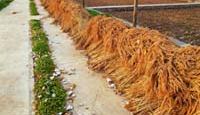 |
 |
 |
The harvested rice is packed to dry up which creates another unique landscape in the campus (photo: Kongjian Yu, Chao Yang). |
 |
 |
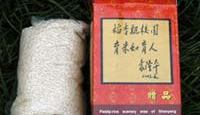 |
 |
 |
Golden Rice becomes an icon: the rice produced on the campus is harvested and distributed as “Golden Rice,” serving both as a keepsake for visitors of the school, and also as a source of identity for the newly established, suburban campus (photo: Kongjian Yu, Chao Yang). |
 |
 |
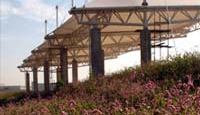 |
 |
 |
Native plants (Polygonum) covering the slopes of the university sports field (photo: Kongjian Yu, Chao Yang). |
 |
 |
|
 |